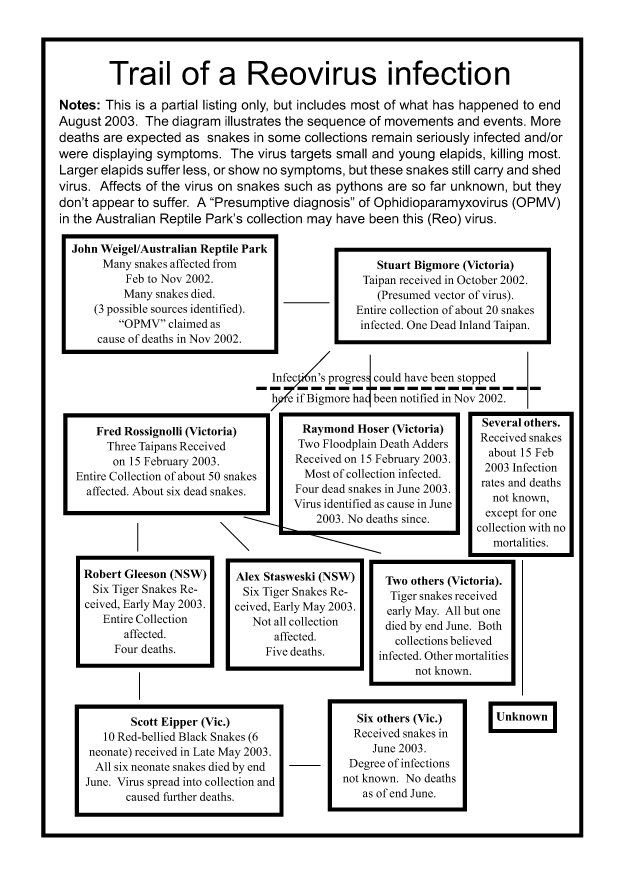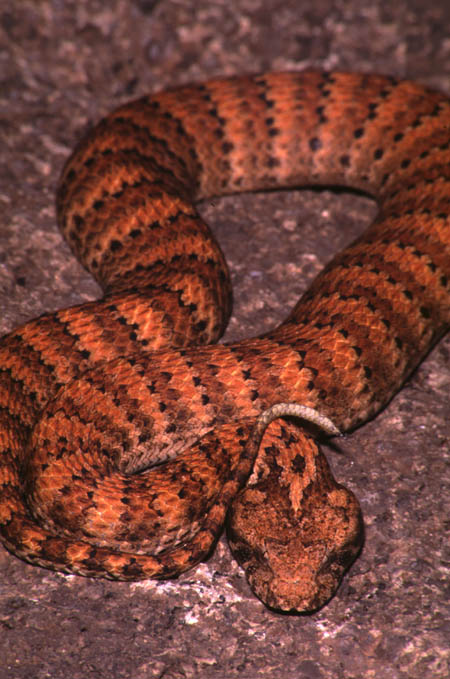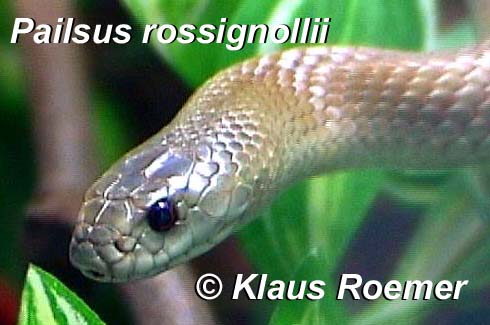|
TAIL THRASHING IN AUSTRALIAN ELAPID SNAKES. |
 Raymond Hoser
Raymond Hoser
488 Park Road
Park Orchards, Victoria, 3114, Australia.
E-mail:adder@smuggled.com
Originally Published in Litteratura Serpentium 25(1):12-18 (2005).
ABSTRACT
Tail thrashing as a sign of arousal and excitement in various species of Australian elapid has not been reported previously.
It has been observed in adult snakes from the genera Acanthophis, Austrelaps, Cannia, Notechis, Panacedechis and Pseudechis. It probably occurs in at least some other genera.
A strong form of tail thrashing occurs in captive snakes in response to sexual arousal in females. It has also been observed in both sexes in response to the introduction of food into the cage of a hungry captive snake, including Tiger Snakes (Notechis) as young as three months old. It has also been observed in males that are forced to confront one another in confined spaces, especially when first introduced to one another in a cage setting.
Tail thrashing should not be confused with caudal luring as seen in Death Adders (Acanthophis) although in that species both behaviors may occur and sometimes virtually in tandem.
INTRODUCTION
Tail thrashing in elapids is described as follows:
The tail held stiffly and is thrashed strongly in a side to side motion. The tail is usually held slightly off the ground and the thrashing plays no part in terms of locomotion or moving the snake forward.
The thrashing is clearly not in a manner to attract food.
When it occurs in response to the introduction of the opposite sex, the non-feeding nature of the response is obvious.
Likewise for when two males meet for the first time in a confined cage and one or both tail thrash.
In terms of thrashing observed when food is introduced into a cage, it is clear that the thrashing is not a form of caudal luring. The most obvious indicator is that the snake thrashing it's tail does not necessarily wait in an ambush position, such as with the tail close to the head.
The 'horse-shoe' type of position of head near wriggling tail is the position seen in caudal luring Death Adders (Acanthophis) and is not the situation seen in the other elapid species known to tail thrash.
I have observed young Tiger Snakes (Notechis) thrashing their tails when hungry and then actively chasing or moving to their food which is placed in the same cage. The tail thrashing continues as the snake moves in a linear manner towards the food and hence there is no possibility that the tail thrashing is a form of caudal luring.
In some cases the thrashing even continues after the snake has commenced feeding on the prey item.
DEATH ADDERS (GENUS ACANTHOPHIS)
These snakes are known to use their tail as a caudal lure.
This has been well documented in the literature, including Hoser (1989).
The tail of these snakes is modified to end in a soft spine and is often a different color to the rest of the body, sometimes being white, cream, black, brown and with or without flecks of other colors.
When using the tail as a lure for food, Death Adders will sit in a characteristic 'horse-shoe' position with the head adjacent to the tail.
In the captive situation, healthy hungry Death Adders will always sit with the head adjacent to the tail.
When the snake commences luring, that indicates that it is hungry.
In the captive situation, Death Adders soon learn to associate the keeper as the source of their food and will often commence luring when the keeper passes or moves the cage.
The intensity of the luring increases at the point that food (usually in the form of a rodent) is introduced to the snake.
The importance of the caudal luring is indicated by the reluctance of most adults to move out of striking range to get the food, preferring instead for the food to approach the snake.
If the snake does move to get the food, this is usually only after a sustained period of caudal luring or if the keeper moves the food away from the snake.
Luring Death Adders have been videotaped by myself on numerous occasions and hence the process is well-known.
Typically this involves the tail twitching along it's latter half, moving in a well-defined continuing S-shaped manner, as in a wriggle.
The tail is not however thrashed strongly from side to side in the sweeping tail-thrashing manner described for the various elapids earlier in this paper.
The only exception to this is when a feeding Death Adder becomes particularly excited by some food nearby.
The twitching frequency will increase from intermittent (stop start) to constant (non-stop) and then becomes more intense until eventually the snake's tail will stop the s-shaped wriggle and break into a thrashing motion from side to side, not unlike that described earlier.
In this case however the thrashing is definitely part of an attempt to attract food via caudal luring, as still evidenced by the proximity of the head to the tail and that the snake will strike food that comes within range.
DISCUSSION
Tail thrashing has been observed in several elapid genera and is probably quite common to many other elapid genera as well. It probably arose to allow one snake to show arousal or excitement to another.
This is evident due to the fact that snakes newly introduced to one another will tend to tail thrash when they make contact.
The process also presumably assists in copulation, which is another situation that it is commonly seen. As the tail is lifted off the ground, the vent is opened up for the male's hemipenis to gain entry.
While tail thrashing is not caudal luring, even though novice keepers may confuse the two, it appears that the ability of snakes to tail thrash may be a precursor to the successful evolution of the ability to use the tail as an effective lure in species such as Death Adders.
That a luring Death Adder breaks into a thrashing motion when particularly excited, may indicate that thrashing is the primitive trait from which luring directly evolved. However this final theory should be investigated before being accepted as fact.
ACKNOWLEDGEMENTS
Several keepers shared their own experiences of this behavior in their collections and also allowed me unfettered access to their live collections of snakes. Included here and with specific reference to this paper were Dave Cavendish, Scott Eipper and Alex Stasweski. Snakes referred to were held under relevant permits issued by authorities in New South Wales, Queensland and Victoria.
REFERENCE
Hoser, R. T. 1989. Australian Reptiles and Frogs, Pierson and Co., Sydney, Australia. 240 pp.


